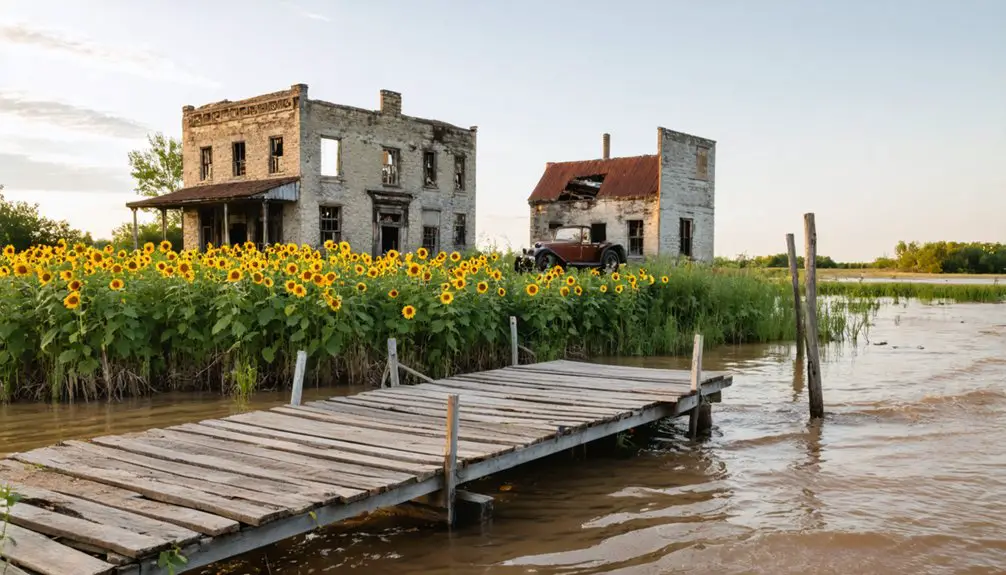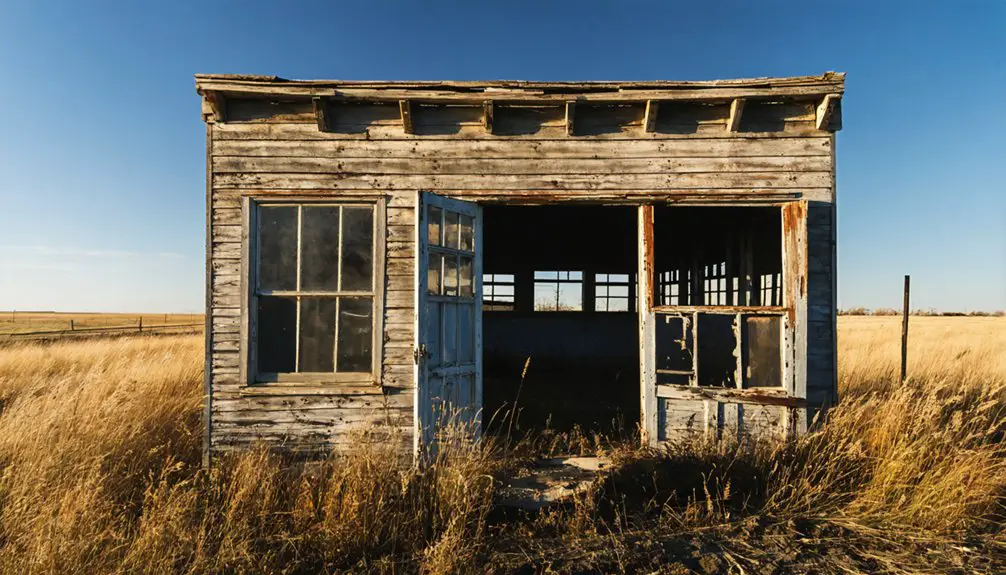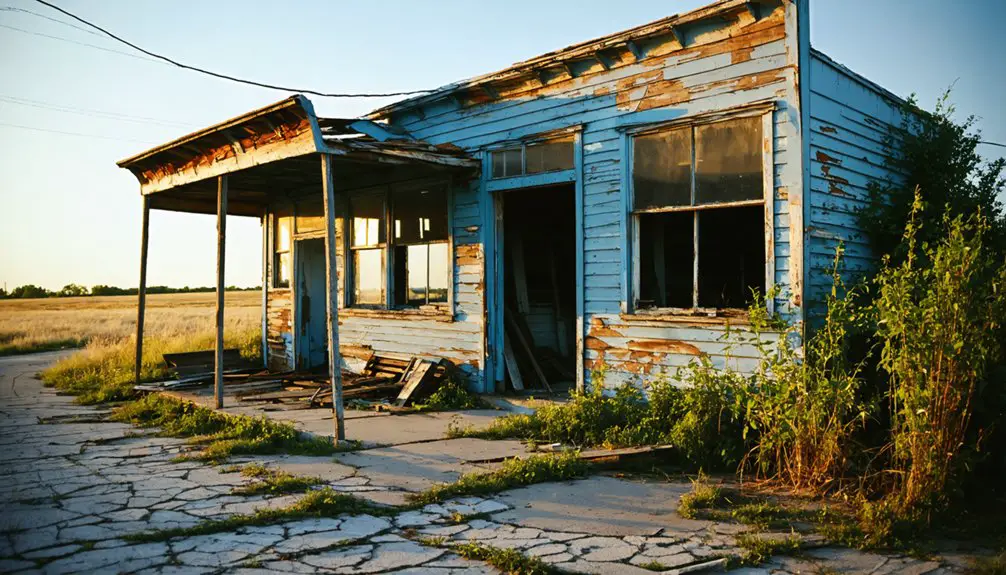You’ll find Boomer City in Kansas’s Greenwood County, where ambitious speculators built a bustling railroad hub in the late 1800s. The town flourished with general stores, water-powered mills, and a vibrant riverfront community centered around François Chouteau’s trading post. Today, nature’s reclaiming the weathered structures and abandoned rail lines, while annual reunions keep the stories alive. The silent foundations and overgrown streets hold secrets of a pioneering spirit waiting to be discovered.
Key Takeaways
- Boomer City emerged during the 19th century westward expansion as a railroad hub, initially thriving with diverse commerce and essential services.
- The town’s decline began in the early 1900s, accelerated by bank closures, loss of railroad connections, and the Great Depression.
- Community life centered around churches, schools, and seasonal celebrations before the town’s abandonment and transformation into a ghost town.
- Today, abandoned buildings, deteriorating infrastructure, and nature-reclaimed areas mark the former site of Boomer City.
- Local organizations preserve the town’s history through annual reunions, oral histories, and archival collections of early settler experiences.
The Birth of a Prairie Town
As the great westward expansion swept across the American frontier, Boomer City emerged from the untamed Kansas prairie during the latter half of the 19th century.
You’d have witnessed ambitious speculators and town founders purchasing vast tracts of land, their eyes set on creating a thriving hub of commerce and civilization where only grass once swayed. The pioneering Lull brothers’ store marked the first commercial establishment in the region.
The settlement patterns followed the iron rails cutting through the plains, with early infrastructure sprouting up strategically near the tracks.
Like iron veins across the prairie, railroads dictated where towns would bloom and settlers would gather.
You’d have found general stores, post offices, and transport depots rising from the soil, while hotels and saloons catered to the steady stream of railroad workers and settlers.
The town’s founders aggressively promoted their vision through newspaper campaigns, drawing pioneers who’d stake their claim in this promising new community on the American frontier. To avoid confusion with similarly named settlements, official documents required disambiguation of locations when referencing the town.
From Prosperity to Decline
While Boomer City initially thrived as a bustling railroad hub through the late 1800s, you’d have witnessed its gradual decline beginning in the early 1900s.
Like many settlements that experienced economic depressions, Boomer City struggled to maintain its commercial vitality through the difficult years.
Similar to Greenwood County which saw its population plummet from twenty thousand residents to mere thousands, Boomer City’s decline was stark and irreversible.
As economic downturns swept across Kansas, the town faced mounting challenges that would seal its fate. Population shifts accelerated as residents sought opportunities elsewhere, leaving behind empty storefronts and quiet streets.
The town’s decline manifested through:
- The closure of the regional bank and post office, severing essential financial lifelines
- A devastating drought that crippled local farming operations, forcing agricultural families to abandon their lands
- The railroad’s decision to redirect major routes, effectively isolating the once-connected community
Life Along the River

Beneath the rolling Kansas hills, life along Boomer City’s riverfront bustled with activity during the town’s early years. You’d have found French fur traders in their rough-hewn cabins, steering through the waters that served as the town’s lifeline. François Chouteau’s warehouse became a vital center of commerce in 1825, drawing traders from across the region.
As river navigation improved, steamboats like the John Hancock transformed the quiet banks into a commercial hub, connecting you to distant markets and opportunities.
You’d have built your home strategically on the bluffs, where flood management wasn’t such a pressing concern, overlooking the bustling waterway below. Early residents relied on buffalo chips and driftwood for their heating and cooking needs.
The riverside community thrived on both commerce and caution – while the water brought prosperity through trade and agriculture, you’d have learned to respect its power.
From the drugstores to the lumber yards, every business near the riverfront played its part in the town’s dynamic story.
The Great Depression’s Impact
The vibrant riverside commerce of Boomer City darkened considerably when the Great Depression struck in the 1930s.
New Deal reforms and government assistance programs provided little relief for the struggling community. The town’s economic struggles intensified as cement sales plummeted and construction ground to a halt. You’d have witnessed a mass rural migration as families packed up their lives, seeking opportunities in larger cities. Like the exodus from black homesteader towns, residents sought better prospects elsewhere.
The devastating combination of economic collapse and the Dust Bowl‘s fury dealt Boomer City a double blow:
- Drought and dust storms ravaged local farmland, forcing both white and Black farmers to abandon their dreams.
- Railroad activity dwindled, severing essential transportation arteries.
- Small businesses shuttered their doors as unemployment spread through the community.
The town’s younger residents departed, leaving aging populations behind.
Infrastructure crumbled, and once-bustling streets fell silent, marking Boomer City’s shift toward ghost town status.
Transportation’s Role in Destiny
Transportation arteries proved decisive in Boomer City’s fate, with railroad access becoming the lifeblood that would determine whether towns flourished or faded into obscurity.
As you explore the transportation evolution that shaped this once-hopeful settlement, you’ll find the harsh reality of being bypassed by essential rail lines sealed its destiny. Without the indispensable connection to Missouri Pacific or Rock Island railroads, Boomer City couldn’t sustain its economic vitality.
Just as early log structures characterized Columbia’s initial development, Boomer City’s primitive buildings would eventually disappear into history.
The economic implications were swift and devastating. You’d have seen farmers struggling to transport their produce to distant markets, while nearby towns with railroad intersections thrived and grew. Kansas history reveals over 6,000 dead towns across the state, many sharing similar transportation-related downfalls.
The old dirt roads that once served the community proved insufficient to maintain population levels, and gradually, buildings began disappearing. Like many Kansas towns of its era, Boomer City’s survival hinged on transportation accessibility it never received.
Daily Life in Peak Years
You’d have found Boomer City’s social life centered around the German-influenced architecture of its civic buildings, where doctors, teachers, and mining managers gathered for both business and pleasure.
During the town’s peak years, you could visit the local mineral springs, stroll through manicured gardens with rose beds, or browse shops while exchanging greetings with the diverse mix of professionals and laborers who called this place home.
Your daily business would have included trips to well-maintained storefronts nestled among eucalyptus trees, where the town’s economic significance was evident in the steady flow of mining and railroad activity that kept commerce humming.
Social Gatherings and Events
During its peak years, social life in Boomer City revolved around a vibrant tapestry of community gatherings that brought neighbors together in celebration and fellowship.
You’d find the town’s social traditions centered around cherished local institutions, where residents forged lasting bonds through shared experiences.
- Churches hosted weekly services, bazaars, and social clubs, while marking life’s milestones through baptisms, weddings, and funerals that drew the entire community together.
- The public school emerged as a dynamic hub for community events, featuring plays, concerts, spelling bees, and athletic competitions that united families.
- Seasonal celebrations punctuated the calendar, with harvest festivals, holiday gatherings, and railroad milestone commemorations bringing music, dancing, and shared meals to the heart of town.
Commerce and Daily Business
While most frontier towns depended on a single industry, Boomer City thrived through a diverse commercial landscape that shaped its peak-era prosperity.
You’d find bustling general stores run by merchants like C.A. Montgomery and E.M. Petersen, where shelves overflowed with essential goods. The commerce evolution brought specialty shops combining services – imagine your local grocer also crafting boots and shoes.
Railroad stations fueled the town’s trading prowess, while strategic placement of machine shops and lumber yards near the tracks showcased forward thinking.
Despite trading challenges from floods and fires, the town’s resilient spirit prevailed. You could conduct business at the bank, visit the doctor or attorney, then unwind at one of several gambling establishments.
Water-powered mills kept the agricultural economy humming, while entertainment venues guaranteed prosperity reached beyond basic necessities.
What Remains Today

As time steadily marches forward, Boomer City stands as a shadow of its former self, with abandoned buildings and deteriorating infrastructure telling the silent story of its decline.
Today, you’ll find nature steadily reclaiming what was once a thriving Kansas community. The abandoned architecture serves as a haunting reminder of the town’s vibrant past.
If you visit Boomer City now, you’ll encounter:
- Weathered wooden structures slowly being overtaken by prairie grass and wild vegetation
- Remnants of the old railway line that once brought life and commerce to the area
- Historical buildings that, despite their deterioration, still hold stories of the town’s prosperous era
The remaining structures stand as silent witnesses to the economic and agricultural changes that transformed this once-bustling community into a ghost town.
Legacy Among Kansas Ghost Towns
When you visit Boomer City today, you’ll find its legacy preserved through the scattered remains that tell a uniquely Kansas ghost town story of hope, expansion, and ultimate decline.
Like many of its contemporaries from the late 1800s, this settlement’s brief existence captures the boom-and-bust pattern so common among Kansas towns that flourished during the railroad era but couldn’t sustain their initial promise.
The town’s weathered foundations and overgrown streets now serve as silent monuments to the pioneering spirit, reminding you of the countless similar communities that once dotted the Kansas landscape during America’s westward expansion.
Historical Impact Today
Though countless ghost towns dot the Kansas landscape, Boomer City stands as a particularly poignant example of how transportation shifts and economic cycles shaped the state’s early settlements. Its historical significance resonates through time as a reflection of frontier ambition and the harsh realities of progress.
Today, you’ll find Boomer City’s cultural heritage preserved through:
- Archaeological remnants that tell the story of frontier life and rural development
- Educational opportunities for those studying Kansas’s settlement patterns and economic changes
- Historical tourism sites that attract enthusiasts seeking connections to the state’s past
Like many Ford County settlements, Boomer City’s evolution from bustling community to ghost town mirrors broader patterns of agricultural mechanization and changing transportation networks. This evolution offers valuable insights into Kansas’s development from frontier territory to modern state.
Preserving Community Memory
The preservation of Boomer City’s legacy rests in the hands of dedicated local organizations and descendants who’ve maintained its rich history through storytelling, photographs, and community gatherings.
You’ll find community stories woven through annual reunions where descendants share oral histories, keeping the spirit of their ancestors alive through vivid historical narratives and cherished photographs.
Local heritage preservation efforts focus on documenting these precious memories through formal surveys and archival collections.
You can experience this rich history through storytelling initiatives that bring together multiple generations, ensuring the town’s memory lives on.
While physical landmarks may fade, preservation associations work tirelessly to maintain descendant connections, recording and sharing tales of early settlers that shaped Boomer City’s unique character in Kansas’s tapestry of ghost towns.
Frequently Asked Questions
Were Any Notable Outlaws or Criminals Associated With Boomer City’s Bank Robberies?
You’ll discover outlaw legends Henry Newton Brown and Ben Wheeler, former lawmen who shocked the region by orchestrating one of history’s bloodiest bank heists at Medicine Valley Bank near Boomer City in 1884.
What Indigenous Tribes Originally Inhabited the Area Before Boomer City’s Establishment?
You’d find the proud Kansa, Osage, and Pawnee tribes thriving here, with their rich tribal heritage and deep cultural significance shaping the land through hunting, farming, and spiritual practices.
Did Any Famous Kansas Politicians or Historical Figures Visit Boomer City?
You won’t find evidence of famous visitors or political connections to the area, as historical records don’t document any notable Kansas politicians or historical figures making stops in this industrial cement town.
What Was the Town’s Population During Its Absolute Peak Year?
You won’t find exact population figures for this town’s peak years, as historical records don’t document specific population trends. Like many Kansas ghost towns, its numbers remain a mystery to modern researchers.
Were There Any Significant Natural Disasters Besides the Dust Bowl?
While you’d expect flood history and earthquake impact records, there’s no documented evidence of major natural disasters specifically affecting Boomer City beyond the devastating Dust Bowl that plagued Kansas in the 1930s.
References
- https://www.youtube.com/watch?v=KL2CXcc_HxY
- https://legendsofkansas.com/kansas-ghost-town-list/
- https://www.youtube.com/watch?v=xCbFN_yLFrk
- https://en.wikipedia.org/wiki/List_of_ghost_towns_in_Kansas
- https://www.youtube.com/watch?v=u3JmiUHeZa8
- https://en.wikipedia.org/wiki/Minneola
- https://digging-history.com/2015/04/01/ghost-town-wednesday-rome-kansas/
- https://www.geotab.com/ghost-towns/
- https://freepages.rootsweb.com/~gtusa/history/usa/ks.htm
- https://www.youtube.com/watch?v=OyBXD18P_j4



